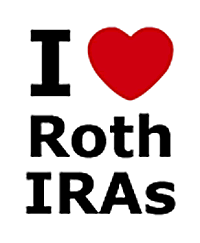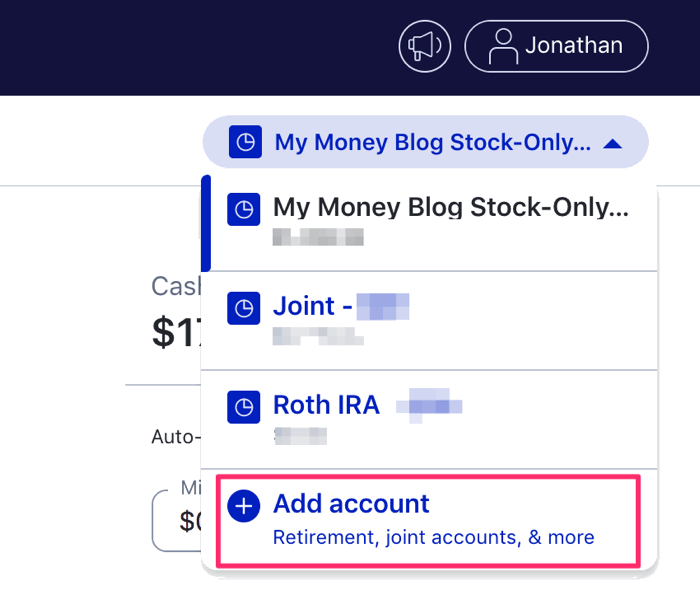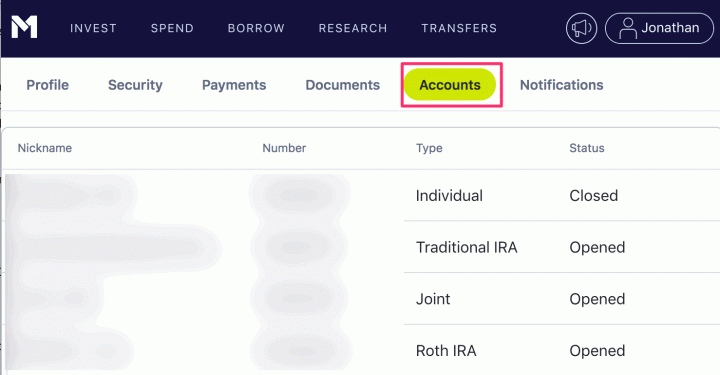 I recently completed a Backdoor Roth IRA contribution at M1 Finance (my review), so here is a detailed step-by-step walkthrough of the process along with screenshots based on my actual experience. M1 Finance currently has a new customer bonus offer up to $150 for new accounts, based on initial deposit amount. You can also add on the up to $2,500 transfer bonus for moving assets over from another brokerage firm. (Disclosure: I am now an affiliate of M1 Finance, and may be compensated if you click through my link and open a new account.)
I recently completed a Backdoor Roth IRA contribution at M1 Finance (my review), so here is a detailed step-by-step walkthrough of the process along with screenshots based on my actual experience. M1 Finance currently has a new customer bonus offer up to $150 for new accounts, based on initial deposit amount. You can also add on the up to $2,500 transfer bonus for moving assets over from another brokerage firm. (Disclosure: I am now an affiliate of M1 Finance, and may be compensated if you click through my link and open a new account.)
Quick background. The Backdoor Roth IRA is a way for individuals to fund a Roth IRA even though their income (modified AGI) exceeds the phaseout limits set for a direct Roth IRA contribution. ($140,000 MAGI for individuals, $208,000 MAGI for married filing joint in 2021.) I won’t go deep into the details, but the general idea is:
- An individual can contribute to a Traditional IRA without any income limits. However, the contribution is not tax-deductible if you exceed the income limits.
- An individual can also convert a Traditional IRA to a Roth IRA, also without any income limits. You won’t owe any taxes on those non-deductible IRA contributions, because they are already after-tax.
- Perform these two steps right after each other, and you have a “Backdoor” Roth IRA.
There are other considerations and details involved, so please do your own research before taking action. Roth conversions cannot be undone. This option may go away in 2022, so if you have any Traditional IRA balances that you have been considering to convert to a Roth IRA, you may want to make your decision before the end of 2021.
M1 Finance Backdoor Roth IRA walkthrough.
Open a new Traditional IRA account and fund it. If you already have an M1 account, click on the name of your portfolio in the top right area, and then click on “Add account”.

Choose “Retirement”, then “Traditional IRA”, then read and accept the terms. Next, you will have the option to select an investment “pie”, but since you are going to convert this quickly to a Roth IRA, it’s fine to just choose something close to cash. One option is the PIMCO Enhanced Short Maturity Active ETF (search for ticker MINT), add it your pie basket, and make it 100%. Finally, you must fund it, probably using your bank account numbers unless you have an existing M1 Finance account or other ideas.
Open a separate Roth IRA account, but do NOT fund it. M1 wants you to have the Roth IRA set up before any conversion request can be made. So start like above and open a new Retirement account, but this time pick Roth IRA. You can now pick your “real” investment portfolio pie, but again don’t fund it! Just think of it as an empty container for now.
Wait for a bit. It may take a few days for your Traditional IRA to get set up, funded, and invested into something. This step is still important. Some people even wait for the Traditional IRA to generate a full monthly account statement so they have paper documentation that they completed this step. Others just wait a day and then move on.
Find both your Traditional and Roth IRA account numbers. It’s conversion time. To find your account numbers, find your name in the top right corner. Click on that, and then click on “View Account Settings”. Then click on the subheading “Accounts”. You should end up with a list of your account nicknames, account numbers, and account types.

Request the conversion, sign and return documents. You can request the conversion via their automated chat bot, secure message, or phone number during business hours. I was able to complete the entire process via chat bot and email without having to use the phone. Here’s my chat transcript with personal details removed:
USER: roth conversion
BOT: M1 Invest can perform IRA conversions. Please keep in mind that due to high volumes, transfers can take 5-7 business days to complete. To get started with this process, please reply with the following information:
BOT: What is the M1 Invest account number of the traditional IRA you would like to convert out of?
USER: XXXXXXXX
BOT: What is the M1 Invest account number of the Roth IRA you would like to convert into?
USER: XXXXXXXX
BOT: What is the amount you would like to convert (if full account conversion, please simply confirm ‘full account’)?
USER: full account
BOT: What is the email address you use to login to M1?
USER: xx@xx.com
Within an hour, they emailed me a PDF form that I had to complete and sign. I uploaded the signed PDF into their secure drop box, and had confirmation that they had sent the request over to their clearing firm within another hour or so.
Jonathan,
We have submitted this conversion to our clearing firm. Both accounts will be paused for the duration of the transfer. We will notify you once the transfer is complete and you will see the funds placed in the correct account.
If you are transferring securities, please make sure the securities you are transferring are located in your Roth IRA portfolio.
This process can take 1-3 business days to complete.
Best,
Brokerage Operations
M1 Team
Once it shows in my M1 Invest dashboard that the funds have been moved into my Roth IRA account, then I’ll be done. I should be sent a form at tax time regarding the amount converted. If I contributed $6,000 to the non-deductible Traditional IRA and the value didn’t change at the time of conversion, then I won’t have any capital gains to pay taxes on. My $6,000 Backdoor Roth IRA contribution will be complete and now I can enjoy tax-free growth and tax-free withdrawals of all future gains. I hope you find this useful for informational purposes.
 The Best Credit Card Bonus Offers – 2025
The Best Credit Card Bonus Offers – 2025 Big List of Free Stocks from Brokerage Apps
Big List of Free Stocks from Brokerage Apps Best Interest Rates on Cash - 2025
Best Interest Rates on Cash - 2025 Free Credit Scores x 3 + Free Credit Monitoring
Free Credit Scores x 3 + Free Credit Monitoring Best No Fee 0% APR Balance Transfer Offers
Best No Fee 0% APR Balance Transfer Offers Little-Known Cellular Data Plans That Can Save Big Money
Little-Known Cellular Data Plans That Can Save Big Money How To Haggle Your Cable or Direct TV Bill
How To Haggle Your Cable or Direct TV Bill Big List of Free Consumer Data Reports (Credit, Rent, Work)
Big List of Free Consumer Data Reports (Credit, Rent, Work)
Be careful with this as you may end up owing more tax on the conversion if you have any other IRAs that have funds in them. (The IRS totals up all of your IRAs and then converts prorated. So if you had $400,000 in IRAs across all of your accounts/brokerages, and then you add $6,000, even to a new one, and convert that $6,000 you are only converting ~1.5% of the post-tax money you contributed. So you are converting $5,911 of your pre-tax IRA and have to pay tax on it.)
In other words, back-door Roth contributions don’t really work for people that already have funded traditional IRAs.
Yikes….glad you pointed this out. I’m moving a certain amount from my Traditional to my Roth on an Annual basis already but was hoping this would be an additional way to get funds into a Roth. Oh well.
When contributing to the traditional IRA are you limited to the current max IRA contribution levels since you are not getting a tax deduction? I already have a Traditional IRA and Roth with them so think I would want to create ANOTHER traditional so as not to mix untaxed money with taxed?
As far as the IRS is concerned you only have one IRA. So everything is combined when they calculate how much tax you owe when doing a Roth conversion. (You don’t get to pick to convert just the post-tax contributions.)
So, from the comments above, it sounds like if you have a big traditional IRA, there’s no way it’ll ever be advantageous to do this backdoor Roth IRA. Is that correct?
As mentioned, there are lots of wrinkles… It is true, if you have existing Traditional IRA balances, they will be considered to be converted to Roth with all other Traditional IRA balances on a pro-rata basis.
However, if you have a pre-tax Traditional IRA that you don’t wish to convert to Roth, you could choose to rollover that balance that into a employer 401k plan (or Solo 401k plan…). Now you have no Traditional IRA and can do the Backdoor Roth IRA. If your employer 401k (or solo 401k) has low costs and good investment options, then this can be a good workaround solution.
Folks may also reconsider whether converting your existing pre-tax IRA to Roth IRA right now may be worth it, those income limits may be reinstated as well. I converted all mine to Roth during a year with lower-than-usual income.
(Edited a few times; I keep mixing up “rollover” and “conversion”)
A point about M1 bonuses: “The total aggregate Deposited Value2 made to an M1 taxable investment account within the first fourteen days of New User Sign-up Date must remain equal to, or greater than, the value after the net deposit was made (minus any losses due to trading, market volatility or margin debit balances) until the Pay-out Date. ” January 31, 2022 (the “Pay-out Date”)
What do you think about M1 Plus checking? Looks like 1% APY and they waive the first year fee. Is this correct? Any downsides?
1% APY is definitely solid for the first year, but I currently use other banking options that pay higher than 1% APY. I like their base service, but I don’t think I would be able to get $125 a year value out of the added perks (after the 1-year free trial).
What if your investment in the traditional IRA has slight gains as you wait for everything to be set up?
You would just owe a little capital gains tax on the amount gained. If your IRA went from $1,000 to $1,010, the Roth IRA would have $1,010 on it and you would ow some taxes on the $10 gain.